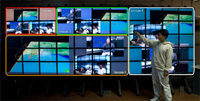SAGE: Scalable Adaptive Graphics Environment
January 1st, 2004 - November 17th, 2013
Categories: Networking, Software, User Groups

About
The Scalable Adaptive Graphics Environment (SAGE) is a distributed computing architecture for supporting two non-trivial problems in visualization. Firstly the majority of visualization tools today are not able migrate from one computing environment to another without requiring that they be redesigned for the new computing environment.
For example: visualization tools that are developed for desktop computers are rarely able to take advantage of the processing power of a cluster of graphics computers; conversely visualization tools developed for clusters rarely function on desktop computers. Secondly, the ability of visualization software and systems to scale in terms of the amount of data they can visualize,and the resolution of the desired visualization, is still an area of intensive computer graphics research.
SAGE addresses the need to support heterogeneity and scalability by decoupling graphics rendering from graphics display and using ultra-high-bandwidth networking, that is just becoming affordable, to bridge between them.
In SAGE, visualization jobs invoked by a user are interpreted by a Visualization Resource Broker and dispatched to the optimal visualization resource available on the network. The chosen system performs the visualization and streams the resulting imagery for display. Note that in some cases it is more economical to render the visualization directly on the tiled display because the data is small enough to fit in the graphics cards’ memory.
A goal of SAGE’s adaptivity is to ensure that this decision is made transparently. Each application that intends to stream images will do so using the Pixel Streaming Interface (PSI)- a highly optimized software library for lossless streaming of pixels over high speed networks. In fact, NTSC or high definition video can also be streamed as long as the camera digitization and streaming software uses the PSI. PSI is based on our prior work in high performance graphics digitization, and high speed data streaming over gigabit networks. The decoupling of the rendering processes from the presentation screen allows SAGE to scalably support distance collaboration by streaming the pixels to all the participating endpoints using either traditional router-based multicasting or photonic multicasting.
SAGE’s FreeSpace Manager provides users with an intuitive interface for moving the visualizations around on the tiled display. When a visualization window is moved from one portion of the screen to another, the FreeSpace Manager’s Pixel Director informs the remote rendering resource of the new destination for the streamed pixels. This gives the user the illusion that they are working on one continuous computer screen even though the systems performing the visualizations may be several hundred miles apart.
The FreeSpace Manager is akin to a traditional desktop manager in a windowing system except that it can scale from a single tabletPC screen to a desktop - spanning 100 million pixels. Furthermore, when a visualization window is enlarged the FreeSpace Manager will give the user the option of either scaling the pixels across the larger screen area, or requesting that the rendering resource generate subsequent visualizations at a resolution that matches the new window size.